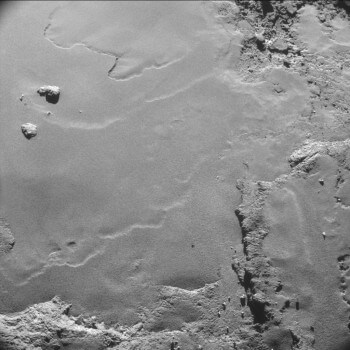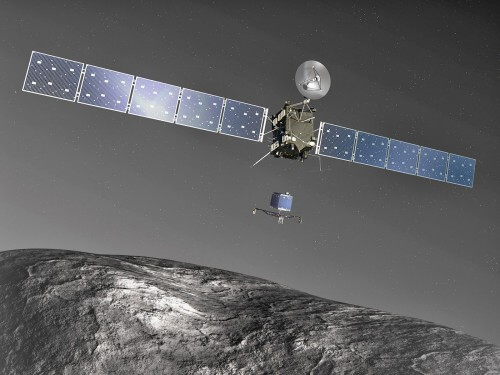This is what Prof. Akiva Bar-Nun from the Department of Earth Sciences at the Faculty of Exact Sciences at Tel Aviv University, a member of the Rosetta team and the mastermind behind the idea for the launch, says in an interview with the site * Only that the lander does not overturn when it touches the ground

The docking of the Philae lander on the nucleus of comet 67P Churyumov-Garsimenko on November 12, 2014 will be an important milestone for science - the first time a spacecraft is expected to make a soft landing on the nucleus of a comet. For Prof. Akiva Bar-Nun from the Department of Earth Sciences in the Faculty of Exact Sciences at Tel Aviv University, this will be an important closing of the circle when 25 years ago he was a member of the group that came up with the idea of launching a spacecraft that would accompany a comet on its way through the solar system and send a lander to its surface. "Today we see our baby ten kilometers above the comet and it is definitely a great joy."
Prof. Akiva Bar-Nun was a member of the scientific committee that decided what the scientific goals of Operation Rosetta were, and since the beginning of the project he has been a member of the group of the University of Bern in Switzerland. "Our group is called Rosina, headed by Kathrine Altwegg, and our job is to constantly sniff above the comet and find out what is emitted from it. As mentioned, we do this using two exceptional mass spectrometers. Swiss thought craft. We check the composition of the gases released from the comet, during its heating, when it approaches the sun and creates the huge halo of water vapor, gases and dust." The Rosetta spacecraft will continue to inspect the nucleus on the comet's journey around the Sun until December 2015.

"The Rosetta project started as a joint project for NASA and the European Space Agency. We wanted to land and bring a sample from the comet back to Earth. We got off that very quickly because the engineers told us that until we knew more or less what the strength of the soil was, it would be impossible to plan anything and they were right. In the absence of gravity, even using a simple drill is very difficult if not impossible because there is nothing to hold the drill close to the ground. That's why the plan was changed to hover over the nucleus and land on it, led by the European Space Agency."
The landing itself is also a challenge, and more than landing on a celestial body like the moon or Mars, it reminds of whaling: "We send bells, shoot them into the ground so that they get stuck in it and keep the spacecraft tied to the ground. It all depends on whether the spacecraft will not overturn as soon as it hits the ground, if it happens to climb on some large block of ice or a high step in the ice, as we see a lot in close-up photographs of the comet's nucleus.
Philae will not take off back from the comet but it will certainly operate the sophisticated chemical laboratory capable of analyzing the composition of materials and based on a mass spectrometer, one of the most sophisticated ever built.
.
The European Space Agency published a list of the substances detected by the mass spectrometers during Rosetta's approach to the comet: water, carbon monoxide (CO), carbon dioxide (CO2), ammonia (NH3), methane (CH4), methanol (CH3OH), formaldehyde (CH2O ), hydrogen sulfide (H2S), hydrogen cyanide (HCN), sulfur dioxide (SO2), carbon disulfide (CS2). Bitter almonds".
Nevertheless, this is a 15-year-old technology
Prof. Bar-Nun: Although this is a 15-year-old technology, I am not aware of such sophisticated mass spectrometers. Their separation is excellent. A mass spectrometer measures the mass of a molecule or atom. When we sent the Giotto spacecraft to Halley's comet, the separation was one mass unit. Therefore it was not possible to differentiate between nitrogen ((N2) and carbon monoxide CO which have a very close mass. The new device has a separation of 1 in 3,000, it separates these two gases very easily. And indeed both were discovered, and many other substances."
What's next, is the landing spot, precisely on the small part of the comet safe?
"As small as the small part of the two connected parts that make up the comet's nucleus looks small, it is still quite large, it has large enough surfaces on it. I trust the people who decided where to land that they thought carefully about what should be done. In this respect they can be trusted. We will have to wait until November 12, at seven o'clock in the evening when the news that Philae has landed will reach Earth. Immediately after it lands, it will take measurements and transmit their results to the European Space Agency. Since it is 25 light minutes away from the Earth, the entire landing must be done automatically, and it was not allowed to control the spacecraft from the Earth.
In conclusion, Prof. Bar-Nun says: "We succeeded well on Titan, when the Huygens spacecraft landed on its surface, and I hope we will succeed now with Philae as well."
More on the subject on the science website

7 תגובות
Note, this is about the distance of Rosetta from the Sun (which is currently about 28 light minutes) Distance from the Sun is not related...
There is probably an error of .25x x60x300,000. It's 450,000,000 km. The distance to the sun is only 150,000,000 km.
I also had a dream yesterday but it took 5 minutes....if u know wut i mean
Wow 25 years I haven't even lived 25 years and not even 9 years I'm also 8 and a half years old.